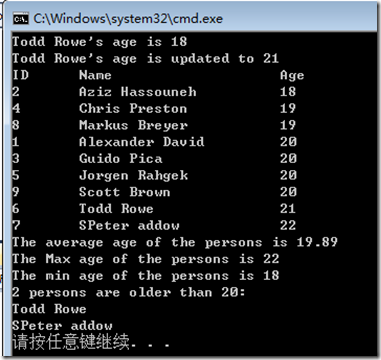Java和C++对于容器中元素的操作已经十分简便智能了,但与C#相比,简直弱爆了。这正是因为C#拥有一个利器:Linq。简单的说,Linq就是利用类SQL语句来操作容器中的元素。这样就完全放弃了编程的思维方式,而采用浅显易懂的数据库操作了。这不得不说是一次重大的突破,不过同时也让C#程序员越来越懒,失去了程序员的血性。
下面简单举个例子,说明Linq的用法。
1、定义一个Person类,包括ID,Nam,Age三个属性。
class Person
{
public Person(int id, string name, int age)
{
this.id = id;
this.name = name;
this.age = age;
}
private int id;
// Person ID
public int PersonID
{
get { return this.id; }
set { this.id = value; }
}
private string name;
// Person name
public string Name
{
get { return this.name; }
set { this.name = value; }
}
public int age;
// Age that ranges from 1 to 100
public int Age
{
get { return this.age; }
set
{
if (value > 0 && value <= 100)
this.age = value;
else
throw new Exception("Age is out of scope [1,100]");
}
}
}
2、创建一个List<Person>作为数据源
// Build the Person List as data source List<Person> persons = new List<Person>(); persons.Add(new Person(1, "Alexander David", 20)); persons.Add(new Person(2, "Aziz Hassouneh", 18)); persons.Add(new Person(3, "Guido Pica", 20)); persons.Add(new Person(4, "Chris Preston", 19)); persons.Add(new Person(5, "Jorgen Rahgek", 20)); persons.Add(new Person(6, "Todd Rowe", 18)); persons.Add(new Person(7, "SPeter addow", 22)); persons.Add(new Person(8, "Markus Breyer", 19)); persons.Add(new Person(9, "Scott Brown", 20));
3、查询
// query a person in the data source.
var Todd = (from p in persons
where p.Name == "Todd Rowe"
select p).First();
Console.WriteLine("Todd Rowe's age is {0}", Todd.Age);
4、更新
// update person's age
Todd.Age = 21;
Console.WriteLine("Todd Rowe's age is updated to {0}", (from p in persons
where p.Name == "Todd Rowe"
select p).First().Age);
5、排序并输出
// sort by person's age
var query1 = from p in persons
orderby p.Age
select p;
Console.WriteLine("ID\tName\t\t\tAge");
foreach (Person p in query1.ToList<Person>())
{
Console.WriteLine("{0}\t{1}\t\t{2}", p.PersonID, p.Name, p.Age);
}
6、获取平均值、最大值、最小值
// avgerage, max, min age of the persons
double avgAge = (from p in persons
select p.Age).Average();
Console.WriteLine("The average age of the persons is {0:f2}", avgAge);
double maxAge = (from p in persons
select p.Age).Max();
Console.WriteLine("The Max age of the persons is {0}", maxAge);
double minAge = (from p in persons
select p.Age).Min();
Console.WriteLine("The min age of the persons is {0}", minAge);
7、特定条件查询(获取20岁以上的人名)
// Count the persons who age is larger than 20
var query2 = from p in persons
where p.Age > 20
select p;
int count = query2.Count();
Console.WriteLine("{0} persons are older than 20:", count);
for (int i = 0; i < count; i++)
{
Console.WriteLine(query2.ElementAt(i).Name);
}
输出结果:
上述示例,参考了MSDN。
